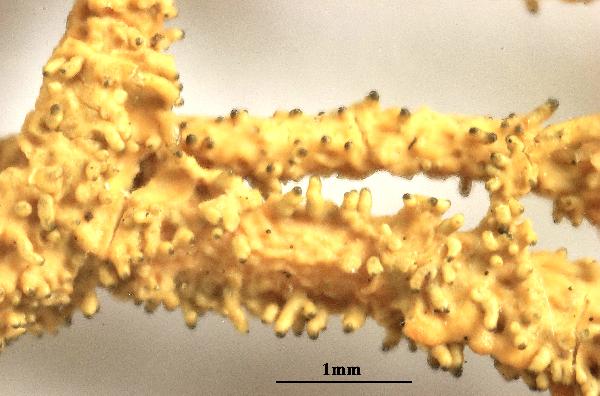Lethariella intricata (Moris) Krog
Norw. J. Bot., 23: 94, 1976. Basionym: Stereocaulon intricatum Moris - El. Stir. Sard., 3: 22, 1827.
Synonyms: Chlorea soleirolii var. arborea Jatta; Letharia soleirolii (Schaer.) Hue; Neuropogon arboricola (Jatta) Jatta; Neuropogon soleirolii (Schaer.) Jatta; Usnea arboricola Jatta; Usnea intricata (Moris) Th. Fr.; Usnea soleirolii (Schaer.) Jatta
Distribution: C - Tosc (Obermayer 1997, Ravera & al. 2010b), Laz (Ravera 2006), Mol (Ravera & al. 2010b), Sar (Obermayer 1997, Nöske 2000, Loi & al. 2000, Zedda & Sipman 2001, Zedda 2002, Ravera & al. 2010b). S - Camp (Ravera & al. 2010b, Ravera & Brunialti 2013), Pugl (Thüs & Licht 2006), Bas (Obermayer 1997, Potenza 2006, Puntillo & al. 2009, Potenza & Fascetti 2012, Potenza & al. 2013, Ravera & al. 2021c), Cal (Puntillo 1996, Obermayer 1997, Potenza & al. 2013, Lich. Ital. Exs. 9: Puntillo & al. 2017), Si (Merlo 2004, Brackel 2008b).
Description: Thallus fruticose, attached with a basal holdfast, shrubby to subpendulous, up to 15 cm long, rather rigid but not fragile, irregularly branched, isidiate. Branches pale grey in basal parts, dark grey in upper parts, terete, with a more or less scrobiculate surface. Isidia usually abundant, irregularly dispersed, at first verruciform, later cylindrical to branched-coralloid, concolorous with the branches or sometimes darkened at tips. Cortex paraplectenchymatous, 30-40 µm thick; medulla dense, forming a hollow axis in the older part of the branches, the cavity with a few hyphal strands, the space between medulla and cortex filled with crystals of calcium oxalates. Apothecia rare, lecanorine, mostly lateral, strongly constricted at base and often subpedicellate, with a brown to finally black disc and a smooth to scrobiculate-verrucose, sometimes isidiate thalline margin. Epithecium brownish; hymenium and hypothecium colourless. Asci 8-spored, clavate, the K/I+ blue tholus penetrated by a faintly amyloid apical cushion with parallel or diverging flanks, the wall K/I-, surrounded by a K/I+ blue outer layer, Lecanora-type. Ascospores 1-celled, hyaline, ellipsoid, 7-9 x 2-3 µm. Pycnidia black, immersed. Conidia pleurogenous, slightly inflated in the center or weakly bifusiform, 8-9 x 1.2-1.5 µm. Photobiont chlorococcoid. Spot tests: thallus K+ yellow, C-, KC-, P-. Chemistry: cortex with atranorin (minor) and chloroatranorin (minor), medulla with merochlorophaeic acid (major), submero-chlorophaeic acid (minor), 4-0-methylcryptochlorophaeic acid (minor); ± fatty acid(s) of the rangiformic/norrangiformic/isorangiformic acid complex.
Note: this is probably an old, relict Mediterranean species found on siliceous rocks and acid bark (e.g. of old Pinus leucodermis near treeline in the Southern Apennines). It is included in the Italian red list of epiphytic lichens as “Near-threatened” (Nascimbene & al. 2013c).
Growth form: Fruticose
Substrata: bark and rocks
Photobiont: green algae other than Trentepohlia
Reproductive strategy: mainly asexual, by soredia, or soredia-like structures (e.g. blastidia)
Most common in areas with a humid-warm climate (e.g. most of Tyrrenian Italy)
Commonnes-rarity: (info)
Alpine belt: absent
Subalpine belt: absent
Oromediterranean belt: absent
Montane belt: very rare
Submediterranean belt: absent
Padanian area: absent
Humid submediterranean belt: absent
Humid mediterranean belt: extremely rare
Dry mediterranean belt: absent

Predictive model
Herbarium samples


P.L. Nimis; Owner: Department of Life Sciences, University of Trieste
Herbarium: TSB (10673)
2002/02/24


P.L. Nimis; Owner: Department of Life Sciences, University of Trieste
Herbarium: TSB (10673)
2001/11/26
detail of isidia


Felix Schumm – CC BY-SA 4.0
Image from: F. Schumm (2008) - Flechten Madeiras, der Kanaren und Azoren. Beck, OHG - ISBN: 978-3-00-023700-3


Felix Schumm - CC BY-SA 4.0
Image from: F. Schumm (2008) - Flechten Madeiras, der Kanaren und Azoren. Beck, OHG - ISBN: 978-3-00-023700-3


Felix Schumm - CC BY-SA 4.0
Image from: F. Schumm (2008) - Flechten Madeiras, der Kanaren und Azoren. Beck, OHG - ISBN: 978-3-00-023700-3

Bernard Bouffinier - Source: http://www.lichensmaritimes.org/index.php?task=fiche&lichen=903&lang=en
France, Corse, à L'Ospedale orientés vers le golfe de Porto-Vecchio

Bernard Bouffinier - Source: http://www.lichensmaritimes.org/index.php?task=fiche&lichen=903&lang=en
France, Corse, à L'Ospedale orientés vers le golfe de Porto-Vecchio

Bernard Bouffinier - Source: http://www.lichensmaritimes.org/index.php?task=fiche&lichen=903&lang=en
France, Corse, à L'Ospedale orientés vers le golfe de Porto-Vecchio, 900 m

Bernard Bouffinier - Source: http://www.lichensmaritimes.org/index.php?task=fiche&lichen=903&lang=en
France, Corse, à L'Ospedale orientés vers le golfe de Porto-Vecchio, 900 m

Bernard Bouffinier - Source: http://www.lichensmaritimes.org/index.php?task=fiche&lichen=903&lang=en
France, Corse, à L'Ospedale orientés vers le golfe de Porto-Vecchio, 900 m

Bernard Bouffinier - Source: http://www.lichensmaritimes.org/index.php?task=fiche&lichen=903&lang=en
France, Corse, à L'Ospedale orientés vers le golfe de Porto-Vecchio, 900 m

Bernard Bouffinier - Source: http://www.lichensmaritimes.org/index.php?task=fiche&lichen=903&lang=en
France, Corse, à L'Ospedale orientés vers le golfe de Porto-Vecchio, 900 m
Growth form: Fruticose
Substrata: bark and rocks
Photobiont: green algae other than Trentepohlia
Reproductive strategy: mainly asexual, by soredia, or soredia-like structures (e.g. blastidia)
Most common in areas with a humid-warm climate (e.g. most of Tyrrenian Italy)
Commonnes-rarity: (info)
Alpine belt: absent
Subalpine belt: absent
Oromediterranean belt: absent
Montane belt: very rare
Submediterranean belt: absent
Padanian area: absent
Humid submediterranean belt: absent
Humid mediterranean belt: extremely rare
Dry mediterranean belt: absent

Predictive model
| Herbarium samples |


P.L. Nimis; Owner: Department of Life Sciences, University of Trieste
Herbarium: TSB (10673)
2002/02/24


P.L. Nimis; Owner: Department of Life Sciences, University of Trieste
Herbarium: TSB (10673)
2001/11/26
detail of isidia


Felix Schumm – CC BY-SA 4.0
Image from: F. Schumm (2008) - Flechten Madeiras, der Kanaren und Azoren. Beck, OHG - ISBN: 978-3-00-023700-3


Felix Schumm - CC BY-SA 4.0
Image from: F. Schumm (2008) - Flechten Madeiras, der Kanaren und Azoren. Beck, OHG - ISBN: 978-3-00-023700-3


Felix Schumm - CC BY-SA 4.0
Image from: F. Schumm (2008) - Flechten Madeiras, der Kanaren und Azoren. Beck, OHG - ISBN: 978-3-00-023700-3

Bernard Bouffinier - Source: http://www.lichensmaritimes.org/index.php?task=fiche&lichen=903&lang=en
France, Corse, à L'Ospedale orientés vers le golfe de Porto-Vecchio

Bernard Bouffinier - Source: http://www.lichensmaritimes.org/index.php?task=fiche&lichen=903&lang=en
France, Corse, à L'Ospedale orientés vers le golfe de Porto-Vecchio

Bernard Bouffinier - Source: http://www.lichensmaritimes.org/index.php?task=fiche&lichen=903&lang=en
France, Corse, à L'Ospedale orientés vers le golfe de Porto-Vecchio, 900 m

Bernard Bouffinier - Source: http://www.lichensmaritimes.org/index.php?task=fiche&lichen=903&lang=en
France, Corse, à L'Ospedale orientés vers le golfe de Porto-Vecchio, 900 m

Bernard Bouffinier - Source: http://www.lichensmaritimes.org/index.php?task=fiche&lichen=903&lang=en
France, Corse, à L'Ospedale orientés vers le golfe de Porto-Vecchio, 900 m

Bernard Bouffinier - Source: http://www.lichensmaritimes.org/index.php?task=fiche&lichen=903&lang=en
France, Corse, à L'Ospedale orientés vers le golfe de Porto-Vecchio, 900 m

 INDEX FUNGORUM
INDEX FUNGORUM
 GBIF
GBIF





















